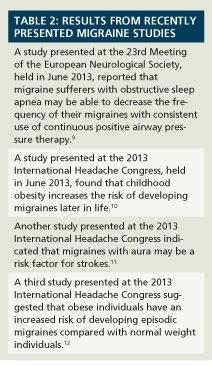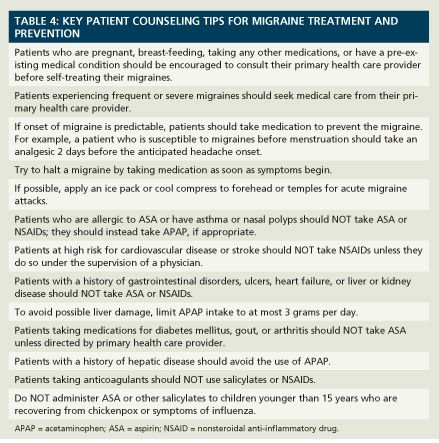Publication
Article
Pharmacy Times
Debilitating, Throbbing Pain: Managing and Treating Migraines
Author(s):
Understanding migraine headaches is critical in guiding patients to relief.
Understanding migraine headaches is critical in guiding patients to relief.
Migraine headaches are a common neurological condition that can profoundly affect one’s overall quality of life.

According to the National Headache Foundation and the American Migraine Study, approximately 30 million people in the United States are affected by migraine headaches.1,2 The World Health Organization (WHO) ranks migraine as number 19 among the medical conditions that contribute most to disability worldwide.1 Migraines most commonly affect patients between the ages of 25 and 50 years, and they are 3 times more prevalent in women than in men.3,4 Approximately 80% of those with migraines have a familial history of the condition, indicating a possible genetic link.1,4-7 In addition, approximately 5% to 10% of children experience migraines.4
Migraine headaches are often characterized by “pounding” pain that is typically unilateral and frequently described as intense and throbbing.1,3-5 Migraine headaches can be categorized into 2 subtypes: those with and without aura.6,7 Approximately 20% of migraine patients fall into the former subtype and may experience an aura with generally abrupt onset before experiencing migraine pain.1,4

Along with pain, some migraine patients also report heightened sensitivity to light, noise, or odors, as well as nausea and vomiting.1,4-7 The typical duration of migraines can range from a few hours up to 3 days.4-7 Many women experience migraine attacks during the premenstrual cycle, but migraines may also occur during and after the menstrual cycle.7 Some women may experience migraines during perimenopause and menopause as well.5,7,8 The exact cause of migraines is not known, but several factors have been identified as triggers for the headaches (Tables 1 and 2).
Nonprescription Therapies
Nonprescription medications currently marketed for the treatment and management of mild to moderate migraines contain analgesics such as acetaminophen (APAP), ibuprofen, and aspirin (ASA). OTC migraine medications are available in a variety of formulations as single-entity or combination products (online Table 3). Some combination formulations, such as Excedrin Migraine, contain caffeine in addition to 1 or more analgesics. Pharmacists should advise patients to read product labels carefully, especially when using multi-ingredient products, to avoid potential toxicities, unnecessary drug use, or therapeutic duplications, since many cough, cold, flu, and allergy medications also contain analgesics.
Table 3: Examples of OTC Analgesics Marketed to Treat Migraine Headaches
- Advil Migraine
- Excedrin Migraine
- Bayer Migraine
- Good Sense Migraine Formula
There are also a number of alternative or natural medications marketed for the relief and management of migraine symptoms, including Hyland’s Migraine Headache Relief Tablets and topical products such as WellPatch Migraine Cooling Pads and Be Kool Migraine Soft Gel Sheets. Other products marketed for migraines include Sinol All-Natural Nasal Spray for Fast Headache Relief, which contains the active ingredient capsaicin, from the pepper plant.
The Role of the Pharmacist
Patients exhibiting signs of an undiagnosed migraine should be referred for further medical evaluation prior to recommending self-treatment to rule out other possible issues (Table 4). Before recommending nonprescription analgesics for mild to moderate migraines, pharmacists should screen for potential allergies, contraindications, and drug­­—drug interactions. Pharmacists should also instruct patients on the medications’ proper use, including their recommended duration of use, and advise patients to take them with food or milk if stomach upset occurs. Pharmacists should also advise patients of the potential adverse effects associated with these products. Patients who experience frequent migraine headaches may be able to decrease their frequency by keeping a headache journal, identifying possible triggers, and avoiding or modifying these triggers. Non-pharmacologic measures that may help alleviate or prevent migraine headaches include relaxation techniques, avoiding stress, eating a balanced diet, and getting an adequate amount of sleep.
Patient Resources on Headaches
- The National Headache Foundation: www.headaches.org
- The American Headache Society: www.achenet.org
- The American Pain Society: www.ampainsoc.org
- The Migraine Research Foundation: http://www.migraineresearchfoundation.org
The majority of mild to moderate migraines can be easily managed through self-treatment and typically only last a few hours at most. However, patients should be encouraged to consult their primary health care provider regarding treatment with prescription medication if they do not obtain relief after using OTC products, if they experience chronic migraines, or if their migraines increase in intensity or frequency. Children experiencing migraine symptoms should always be referred to their primary health care provider to determine the best and safest treatment option.

Ms. Terrie is a clinical pharmacy writer based in Haymarket, Virginia.
References
- Reddy D. The pathophysiological and pharmacological basis of current drug treatment of migraine headache. Expert Rev Clin Pharmacol. 2013;6(3):271-288.
- Lipton RB, Stewart WF, Diamond S, Diamond ML, Reed M. Prevalence and burden of migraine in the United States: data from the American Migraine Study II. Headache 2001;41(7):646-657.
- Stovner LJ, Hagen K. Prevalence, burden, and cost of headache disorders. Curr Opin Neurol. 2006;19(3):281-285.
- American Headache Society. Migraine headaches. www.achenet.org/resources/types_of_headaches/#migraine. Accessed July 26, 2013.
- National Institute of Neurological Disorders and Stroke. Headache: hope through research. www.ninds.nih.gov/disorders/headache/detail_headache.htm. Accessed July 26, 2013.
- Migraines. National Headache Foundation. www.headaches.org/educational_modules/completeguide/migraine2.html. Accessed July 26, 2013.
- Wilkinson J, Remington T. Headache. In: Krinsky D, Berardi R, Ferreri S, et al, eds. Handbook of Nonprescription Drugs. 17th ed. Washington, DC: American Pharmacists Association; 2012.
- National Headache Foundation. Migraine precipitating factors. www.headaches.org/educational_modules/completeguide/migraine3.html. Accessed July 26, 2013.
- Keller D. CPAP improves migraine burden in patients with sleep apnea. Medscape website. www.medscape.com/viewarticle/806902. Accessed July 26, 2013.
- Anderson P. Obesity in childhood linked to later migraine. www.medscape.com/viewarticle/807382. Accessed July 26, 2013.
- Migraine with aura “major” contributor to all stroke types. Medscape website. www.medscape.com/viewarticle/806983. Accessed July 26, 2013.
- Anderson P. Obesity increases risk for episodic migraine. Medscape website. www.medscape.com/viewarticle/806930. Accessed July 26, 2013.







